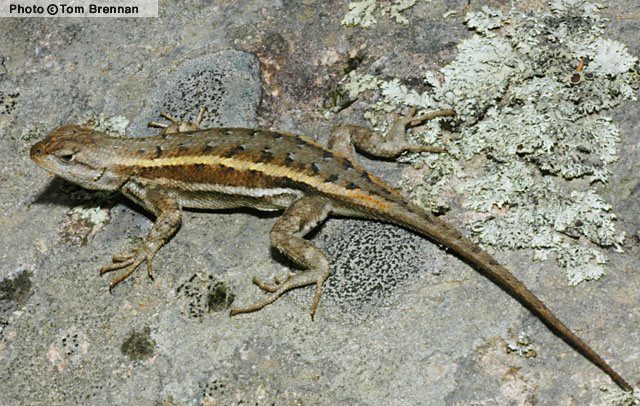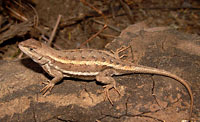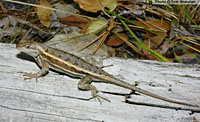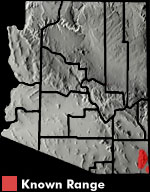Online Field Guide to The Reptiles and Amphibians of Arizona



Cochise County, AZ
 Cochise Co., AZ |
| STRIPED PLATEAU LIZARD Sceloporus virgatus | |
|
DESCRIPTION: A small (up to 70 mm or 2.75″ from snout to vent), dark gray-brown to orange-brown lizard with pointed, keeled scales and two creamy yellow stripes on the back. The stripes extend from the neck to the base of the tail. An additional pale gray to white stripe marks each lower side of the body. There are usually two rows of small, dark gray-brown blotches running the length of the back. A small, white dot is usually present on the inside rear edge of each blotch. The mid-dorsum is often marked with a faint, wide, gray-brown stripe. The underside is plain and pale, occasionally with some dark flecking on the chest and throat. Two small blue patches may develop on the throat during breeding season (spring). Gravid females may develop orange coloration surrounding or replacing the blue patches on the throat. Males are usually darker brown and often lack dorsal blotches. Its lack of belly markings distinguishes this lizard from other Sceloporus found in the area. The scales on the sides of the body are arranged in diagonal rows (spines point up and back) distinguishing this lizard from Slevin’s Bunchgrass Lizard. DISTRIBUTION: In Arizona the Striped Plateau Lizard is found only in the Chiricahua and Peloncillo mountains. It occurs at elevations ranging from about 4,800’ to over 8,500′. HABITAT: The Striped Plateau Lizard inhabits Madrean Evergreen Woodland, Petran Montane Conifer Forest, and Petran Subalpine Conifer Forest communities. This mountain dweller is usually encountered in relatively open, sunlit areas along rocky canyon bottoms and slopes. BEHAVIOR: This diurnal lizard is primarily a ground-dweller but it climbs onto fallen logs and low rocks to bask. Young animals can be active at any time of the year but winter activity is restricted to unseasonably warm and sunny days. Adults hibernate during the cold months of winter and late fall.It does not hesitate to climb onto trees to avoid capture. Both males and females are territorial. DIET: Grasshoppers and a variety of other insects make up the diet of this lizard. It has also been reported to eat centipedes. By Thomas C. Brennan
Degenhardt, W. G., Painter, C. W., and Price, A. H.. 1996. Amphibians and Reptiles of New Mexico. University of New Mexico Press. Albuquerque. Stebbins, R.C. 2003. A Field Guide to Western Reptiles and Amphibians, Third Edition. Houghton Mifflin Company, Boston, MA. |
|
Visit Partners in Amphibian and Reptile Conservation:


HOME
Copyright © 2023, Arizona Game and Fish Department. All rights reserved.
If you make use of the textual contents of this site in reports, publications, etc. please cite and credit the author(s) and photographer(s). All photos on this website are copyrighted. However, those found in the species account section may be used for any noncommercial scientific, educational, or conservation purposes provided that photographs are not altered and continue to bear the copyright symbol and name of the photographer. Please contact the photographer regarding commercial use of copyrighted photographs.












